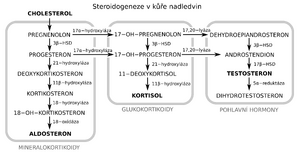Androgens (physiology)
Androgens are male sex hormones. They are responsible for the development of the male type of genitalia during prenatal development as well as for the growth of the genitals and the development of secondary sex characteristics during puberty.
Testosterone
- Testosterone is the basic male sex hormone. It is responsible for most of the physiological effects of androgens. In addition to the development and growth of male genitals, it has a significant effect on the skin , an anabolic effect , increases the density of bone tissue and supports erythropoiesis .
 For more information see Testosterone.
For more information see Testosterone. - Dihydrotestosterone
- Dihydrotestosterone (DHT) is formed from testosterone in some target tissues (prostate, scrotum, penis, bones). It has higher androgenic effects than testosterone, thereby amplifying the signal.
- Dihydroepiandrosterone
- Dihydroepiandrosterone (DHEA) is unable to activate the androgen receptor and therefore lacks androgenic effects. However, it is an important substrate for the production of testosterone .
Androgen secretion and its regulation[edit | edit source]
Most of the testosterone secreted into the blood comes from the Leydig cells in the testicles (60–95 % depending on the state of the organism and the literature used), the rest is secreted by the adrenal cortex. Secretion from both glands is controlled by the hypothalamo-pituitary system, however, individual glands respond to different hormones.
- Leydig cell secretion is controlled by pituitary luteinizing hormone. The hypothalamus produces gonadoliberin, which stimulates the pituitary gland to produce luteinizing hormone and follicle-stimulating hormone. Luteinizing hormone subsequently stimulates the Leydig cells to secrete testosterone. The production of gonadoliberin from the hypothalamus and luteinizing hormone from the pituitary gland is feedback inhibited by testosterone, but also by estrogens.
- The secretion of the adrenall cortex is under the control of another pituitary hormone - adrenocorticotropin (ACTH). The hypothalamus secretes corticoliberin, which stimulates the pituitary gland to secrete ACTH, and which stimulates the adrenal cortex to secrete androgens and glucocorticoids. Feedback is also different in this case. The secretion of corticoliberin and ACTH is inhibited by the presence of glucocorticoids in the blood, not androgens as is the case with secretion by Leydig cells.
Androgen synthesis[edit | edit source]
Testosterone synthesis takes place mainly in the Leydig cells of the testicles and adrenal cortex. The starting substance for synthesis is cholesterol (the synthetic pathway from cholesterol to testosterone is shown in the figure).
The first three reactions can only take place in glands with internal secretion, i.e. testicles and adrenal glands, other tissues lack the appropriate enzymatic equipment. However, many target tissues can synthesize androgens from DHEA circulating in the blood.
Primarily in the prostate, testes, penis and bone tissue, testosterone is reduced to DHT, its product with a much higher affinity for receptors and therefore with a much higher effect.
Links[edit | edit source]
Related articles[edit | edit source]
References[edit | edit source]
- SHARIFI, Nima – AUCHUS, Richard J. Steroid biosynthesis and prostate cancer. Steroids. 2012, y. 77, vol. 7, p. 719-726, ISSN 0039-128X.
- SILBERNAGL, Stefan – DESPOPOULOS, Agamemnon. Atlas fyziologie člověka : 186 barevných tabulí. 6. edition. Grada, 2004. ISBN 978-80-247-0630-6.
- SORONEN, P. Sex steroid hormone metabolism and prostate cancer. Journal of steroid biochemistry and molecular biology. 2004, y. 92, p. 281-286, ISSN 0960-0760.
- TROJAN, Stanislav. Lékařská fyziologie. 4. edition. Grada, 2003. ISBN 80-247-0512-5.
Recommended reading[edit | edit source]
- SILBERNAGL, Stefan – DESPOPOULOS, Agamemnon. Atlas fyziologie člověka : 186 barevných tabulí. 6. edition. Grada, 2004. ISBN 978-80-247-0630-6.
- TROJAN, Stanislav. Lékařská fyziologie. 4. edition. Grada, 2003. ISBN 80-247-0512-5.


